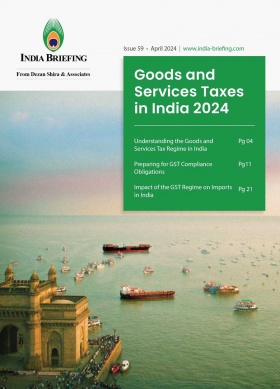Eight National Highway Projects Sanctioned, Expected to Boost India’s Connectivity
India has approved eight national high-speed road corridor projects spanning 936 km, with an investment of INR 506.55 billion (US$6.03 billion) to enhance logistics efficiency and connectivity.
In August 2024, India’s Cabinet Committee on Economic Affairs, sanctioned these projects, which include the 6-lane Agra-Gwalior, 4-lane Kharagpur-Moregram, 6-lane Tharad-Deesa-Mehsana-Ahmedabad, 4-lane Ayodhya Ring Road, the Pathalgaon-Gumla section of the Raipur-Ranchi Corridor, and the 6-lane Kanpur Ring Road.
Enhancing traffic capacity and reducing travel time
The sanctioned projects are expected to boost the country’s infrastructure, economy, and employment. The Agra-Gwalior Corridor is expected to double traffic capacity in the region and significantly reduce travel time and logistics costs. The 231 km Kharagpur-Moregram Corridor, developed under Hybrid Annuity Mode (HAM) at INR 102.47 billion (US$1.2 billion), will quintuple traffic capacity, linking West Bengal, Odisha, Andhra Pradesh, and the northeastern states.
|
Project name |
Length |
Mode |
Cost (value in INR billion) |
|
6-Lane Agra – Gwalior National High-Speed Corridor |
88 kms |
Build-Operate-Transfer (BOT) |
46.13 (US$549 million) |
|
4-Lane Kharagpur – Moregram National High-Speed Corridor |
231 kms |
Hybrid Annuity Mode (HAM) |
102.47 (US$1.2 billion) |
|
6-Lane Tharad – Deesa – Mehsana – Ahmedabad National High-Speed Corridor |
214 kms |
Build-Operate-Transfer (BOT) |
105.34 (US$1.25 billion) |
|
4-lane Ayodhya Ring Road |
68 kms |
Hybrid Annuity Mode (HAM) |
39.35 (US$468 million) |
|
4-Lane Section between Pathalgaon and Gumla of Raipur-Ranchi National High-Speed Corridor |
137 kms |
Hybrid Annuity Mode (HAM) |
44.73 (US$532 million) |
|
6-Lane Kanpur Ring Road |
47 kms |
Engineering, Procurement and Construction (EPC) |
32.98 (US$392 million) |
|
4-Lane Northern Guwahati Bypass and Widening/Improvement of Existing Guwahati Bypass |
121 kms |
Build Operate Toll (BOT) |
57.29 (US$682 million) |
|
8-Lane Elevated Nashik Phata – Khed Corridor near Pune |
30 kms |
Build Operate Toll (BOT) |
78.27 (US$932 million) |
Source: PIB
There are three models of road infrastructure development in India.
In the EPC model, private entities are responsible only for construction, with the government handling maintenance and ownership.
In the BOT-Annuity model, private companies build, operate, and maintain the roads for a specific period before handing them over to the government, receiving a fixed annuity for their services.
The Hybrid Annuity Model (HAM) involves a mix of public and private financing, with the government funding 40 percent of the project and the private developer arranging the remaining 60 percent, including a mix of their own equity and debt.
Macro-economic view of the sector
India boasts one of the world’s largest road networks, stretching over 5.8 million kilometers. This network includes approximately two percent national highways and three percent state highways, with the remainder consisting of district and rural roads.
In India, roads are the primary mode of transport for both goods and passengers, carrying over 64.5 percent of goods and 90 percent of passenger traffic.
In October 2021, a Model Concessionaire Agreement (MCA) for Multimodal Logistics Parks (MMLPs) under the Bharatmala Pariyojana was finalized. The Bharatmala Pariyojana plans to develop 35 MMLPs with an investment of INR 460 billion (US$5.4 billion), capable of handling 700 million metric tonnes of cargo.
The Bharatmala Pariyojana is an ongoing national road and highway construction project. The project, announced in 2015 to enhance the movement of goods and people, focuses on developing 34,800 km of National Highways through “corridor-based” development. Key components include economic corridors, inter-corridor and feeder routes, national corridors efficiency improvement, and connectivity roads for borders, ports, and expressways.
As of 2024, the scheme has awarded contracts for a total of 26,425 km of highways, with 18,180 km already completed. According to India’s Ministry of Road Transport and Highways, India will soon have a Master Plan for National Highways under the Bharatmala project. The objective of this master plan is to enhance logistics through expressways and high-speed corridors.
India has set a target of becoming a US$5 trillion economy by 2025, and to achieve this vision, it is critical to expand and develop its economic corridors. The road and highway sector makes up about 18 percent of the National Infrastructure Pipeline.
In a year-end review 2023 document, the ministry of road and highways states that India has about 66.71 lakh km of road network, which is the second largest in the world.
- National Highways: 1,46,145 km
- State Highways: 1,79,535 km
- Other Roads: 63,45,403 km
Of the total national highway network, approximately 48,422 km consist of more than four lanes, 84,705 km have two lanes, and 13,000 km have fewer than two lanes. There are 969 national highways across various states. Additionally, the country has highway lighting installed on approximately 25,400 km, including 105 km in Assam.
Challenges and future targets
Despite increasing the pace of national highway expansion, India has also missed several highway construction targets in the past 10 years. During the pandemic-hit FY 2020-21, highway construction reached a peak of 37 km per day, totaling 13,327 km that year. However, subsequent targets have been adjusted downward, with 10,457 km built in FY 2021-22 and 12,349 km in FY 2022-23, falling short of the initial ambitious goals.
In the Union Budget for 2024-25, the budgetary allocation for the Ministry of Road Transport and Highways (MoRTH) remained steady at INR 278 billion (US$3.3 billion), a 3 percent increase from the previous year’s interim budget of INR 270 billion (US$3.2 billion).
So far, India has fallen short of achieving its target to construct 13,000 km and 13,800 km of highways in 2022-23 and 2023-24, respectively, due to adverse weather, general elections and state elections.
The MoRTH, however, managed to complete 12,349 km of national highways in 2023-24, up from 10,993 km the previous year.
Of the total financial budget announced in July 2024, the National Highways Authority of India (NHAI) received INR 168 billion (US$2 billion), a 3.9 percent rise from the previous year’s INR 162 billion (US$1.9 billion). The government has continued its policy of minimal market borrowing for the third consecutive year, relying instead on budgetary support to reduce NHAI’s debt. The NHAI’s debt, which stood at INR 335 billion (US$3.9 billion) as of March 2024, has grown 14-fold since 2014-15, prompting India to aim for a reduction to INR 100 billion (US$1.19 billion) by 2024-25.
Summary
India has approved eight high-speed road corridor projects totaling 936 km, with an investment of INR 506.55 billion (US$ 6.03 billion), to improve logistics and connectivity. These projects aim to boost traffic capacity, reduce travel time, and enhance economic and employment prospects. Despite expansion efforts, India has missed several highway construction targets. The road and highway sector are crucial to India’s goal of becoming a US$5 trillion economy by 2025.
(US$1 = INR 83.95)
- Previous Article Capital Gains Tax in India: An Explainer
- Next Article Record Turnover for India’s Auto Component Industry: Details Here








